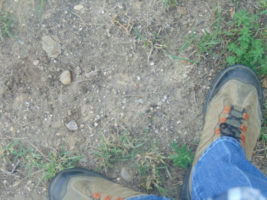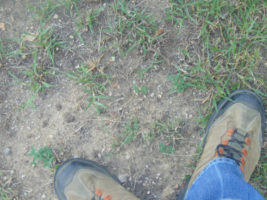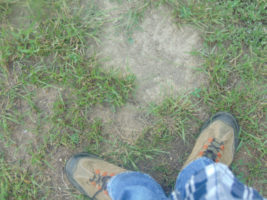In the last couple weeks, we have seen some precipitation. Rapidly moving thunderstorms with intense rain for a short period has been the norm across the Pikes Peak region. Rangeland is still green in August.
A word of caution: All that’s green isn’t grass. When looking over your rangeland it looks green indicating something is growing. Walk out a ways and look down. Is there more bare ground than plant cover? Does the grass appear less green than you observed looking out horizontally? Maybe it isn’t as good as you thought. Looking horizontally across range gives a false impression. Literally, a little green goes a long way. Looking down gives a completely different picture of what is going on.
Put your heels together and set your feet at a 90 degree angle. This creates roughly 1 square foot area to judge ground cover and how much soil is exposed. Think in terms of percentages and mentally push the plants to one side. Then say the plant cover is 30% or 10% of the square foot. It is a mental exercise but with practice will enable you to really judge what you are seeing. Bare ground is normal but when plants occupy less than 20% it is cause for concern.
Examining the soil can show capping or hardening of the surface. Water should be infiltrating but is now running off. Little water permeates the hard surface and any residue which should be incorporated into the soil is washed off. As this hardened soil condition continues, plants are lost and more soil exposed. What happens on a small scale leads to deterioration on a large scale. Small channels are the beginning of gullies. It starts on a small scale. Healthy rangeland lets most of the rain infiltrate and supply water to the plant roots. When the soil is capped, most rain runs off and is lost to the plants.
The hardening of the soil surface is more common on clay or silt soils but similar micro effects happen on sand. The surface will harden when exposed to wind or rain. Common sense says for water to get in, soil must be open with a crumbly surface texture. Snow or rain can get into the soil to support the plants. Plant crowns should be at or slightly above the soil surface so they are protected from extreme cold and grazing. Litter or residue should be easy to see and pick up. This slows the raindrops, breaks the wind and protects the seedlings from harsh conditions.
Looking down will show what the range condition really is better than looking across the landscape at what looks to be there because all that’s green isn’t grass.
The NRCS, Double El Conservation District and the Agate Conservation district are located at 504 Washington in Simla – Contact Us for answers your rangeland questions.




